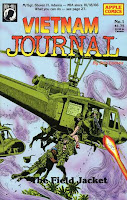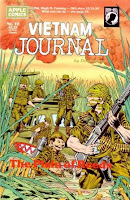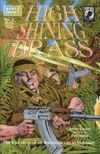 Vietnam Journal was written and drawn by Don Lomax, published by Apple Comics in 1987-91. Unfortunately, it went a mere 16 issues. I didn't get on board until the 8th issue, so I can't comment on the quality of the first 7, but I'm going to take a SWAG here and say they were as good as the 9 issues I did get.
Vietnam Journal was written and drawn by Don Lomax, published by Apple Comics in 1987-91. Unfortunately, it went a mere 16 issues. I didn't get on board until the 8th issue, so I can't comment on the quality of the first 7, but I'm going to take a SWAG here and say they were as good as the 9 issues I did get. The stories were told from the perspective of Scott Neithammer, a print journalist in Vietnam in 1967-68. Not surprisingly, everyone calls him Journal. Lomax clearly knows his subject exceedingly well. He served in Vietnam during the war, though not in a combat role. His respect for the troops who did is utterly foremost in these stories. On the other hand, he doesn't blame the media for the war's course or it's less than satisfying end. He does not like the rear echelon sorts in charge of the war and pins much of the nonsensical tactics employed in the war on their chests.
But neither the political direction of the war nor the competence, or lack thereof, of the military command are the main lines of inquiry. Instead, Lomax takes a hard look at what the war does to the young men fighting it. Whether those men come out on the side of their better angels or succumb to the demons the environement fosters all too easily, he sympathizes with the troops above all. He also has a special fondness for the Kit Carson scouts, ex-Viet Cong who now help the US troops. His portrayals of them are unfailingly positive.
I started buying this series either because I was subcribing to the Comics Buyers Guide at the  time, which gave it glowing reviews, or the cover to issue 8 was particularly arresting. Maybe both. Self immolating monks, even drawn, are sure to get your attention. Journal, at this point, is recovering from wounds received in the last issue, and hallucinating about the many dead he's seen in the war. He heads to Hawaii for some mental recovery time and, once there, talks to a soldier in a bar who's lost both legs and one arm. At the end, war protestors who started out accusing the soldier of being a baby killer instead welcome him home and thank him for his service. It sounds like wishful thinking, but the way it's told, it comes across believably.
time, which gave it glowing reviews, or the cover to issue 8 was particularly arresting. Maybe both. Self immolating monks, even drawn, are sure to get your attention. Journal, at this point, is recovering from wounds received in the last issue, and hallucinating about the many dead he's seen in the war. He heads to Hawaii for some mental recovery time and, once there, talks to a soldier in a bar who's lost both legs and one arm. At the end, war protestors who started out accusing the soldier of being a baby killer instead welcome him home and thank him for his service. It sounds like wishful thinking, but the way it's told, it comes across believably.
 time, which gave it glowing reviews, or the cover to issue 8 was particularly arresting. Maybe both. Self immolating monks, even drawn, are sure to get your attention. Journal, at this point, is recovering from wounds received in the last issue, and hallucinating about the many dead he's seen in the war. He heads to Hawaii for some mental recovery time and, once there, talks to a soldier in a bar who's lost both legs and one arm. At the end, war protestors who started out accusing the soldier of being a baby killer instead welcome him home and thank him for his service. It sounds like wishful thinking, but the way it's told, it comes across believably.
time, which gave it glowing reviews, or the cover to issue 8 was particularly arresting. Maybe both. Self immolating monks, even drawn, are sure to get your attention. Journal, at this point, is recovering from wounds received in the last issue, and hallucinating about the many dead he's seen in the war. He heads to Hawaii for some mental recovery time and, once there, talks to a soldier in a bar who's lost both legs and one arm. At the end, war protestors who started out accusing the soldier of being a baby killer instead welcome him home and thank him for his service. It sounds like wishful thinking, but the way it's told, it comes across believably.At first I thought there was going to be a long running plot line of Journal's run ins with a CIA  agent named Henry Rhein, also known as Yellow Rain for his long blonde hair. When he's introduced in issue 8, Journal clearly has run into him previously, and not positively. He shows up again in issue 10, manipulating some special ops guys into helping out a local drug kingpin steal a large stash from some other drug dealers who were using it to help fund the Viet Cong. Rhein's of a amoral bent, rationalizing that drugs sold to our troops by a drug dealer not supporting the Viet Cong is better than having the money go to the Viet Cong. That Rhein and the drug dealer try to kill off all the special ops guys is of no consequence.
agent named Henry Rhein, also known as Yellow Rain for his long blonde hair. When he's introduced in issue 8, Journal clearly has run into him previously, and not positively. He shows up again in issue 10, manipulating some special ops guys into helping out a local drug kingpin steal a large stash from some other drug dealers who were using it to help fund the Viet Cong. Rhein's of a amoral bent, rationalizing that drugs sold to our troops by a drug dealer not supporting the Viet Cong is better than having the money go to the Viet Cong. That Rhein and the drug dealer try to kill off all the special ops guys is of no consequence.
 agent named Henry Rhein, also known as Yellow Rain for his long blonde hair. When he's introduced in issue 8, Journal clearly has run into him previously, and not positively. He shows up again in issue 10, manipulating some special ops guys into helping out a local drug kingpin steal a large stash from some other drug dealers who were using it to help fund the Viet Cong. Rhein's of a amoral bent, rationalizing that drugs sold to our troops by a drug dealer not supporting the Viet Cong is better than having the money go to the Viet Cong. That Rhein and the drug dealer try to kill off all the special ops guys is of no consequence.
agent named Henry Rhein, also known as Yellow Rain for his long blonde hair. When he's introduced in issue 8, Journal clearly has run into him previously, and not positively. He shows up again in issue 10, manipulating some special ops guys into helping out a local drug kingpin steal a large stash from some other drug dealers who were using it to help fund the Viet Cong. Rhein's of a amoral bent, rationalizing that drugs sold to our troops by a drug dealer not supporting the Viet Cong is better than having the money go to the Viet Cong. That Rhein and the drug dealer try to kill off all the special ops guys is of no consequence. 
Rhein disappears after this story line, though. The remaining stories are different setting and different troop elements that Journal accompanies to  gather stories. An Aussie and a New Zealander show up in one. The futility of taking a hill just to give it back is looked at from the ground troops' view. Even the story of a three legged dog who can sniff out Viet Cong is presented (though it ends poorly for the dog, who ends up stew).
gather stories. An Aussie and a New Zealander show up in one. The futility of taking a hill just to give it back is looked at from the ground troops' view. Even the story of a three legged dog who can sniff out Viet Cong is presented (though it ends poorly for the dog, who ends up stew).
 gather stories. An Aussie and a New Zealander show up in one. The futility of taking a hill just to give it back is looked at from the ground troops' view. Even the story of a three legged dog who can sniff out Viet Cong is presented (though it ends poorly for the dog, who ends up stew).
gather stories. An Aussie and a New Zealander show up in one. The futility of taking a hill just to give it back is looked at from the ground troops' view. Even the story of a three legged dog who can sniff out Viet Cong is presented (though it ends poorly for the dog, who ends up stew). The last two issues are a two part story of an insertion team that's cut off from it's pick up point  and the Air Cav teams that try to rescue them over the course of a couple days. The insertion team does not fair well. Most are killed by Viet Cong, while two others are killed while being held prisoner. The last two escape, but one takes a bullet in his leg which is clearly infected and gangrenous. He makes the other promise to kill him if it looks like they're going to be captured, which the other does when he hears voices speaking Vietnamese, not realizing these are Kit Carson scouts looking for them. After telling Journal the story, this last survivor takes a long walk out the back door of a transport helicopter. Not what you'd call ending on a feel good note.
and the Air Cav teams that try to rescue them over the course of a couple days. The insertion team does not fair well. Most are killed by Viet Cong, while two others are killed while being held prisoner. The last two escape, but one takes a bullet in his leg which is clearly infected and gangrenous. He makes the other promise to kill him if it looks like they're going to be captured, which the other does when he hears voices speaking Vietnamese, not realizing these are Kit Carson scouts looking for them. After telling Journal the story, this last survivor takes a long walk out the back door of a transport helicopter. Not what you'd call ending on a feel good note.
 and the Air Cav teams that try to rescue them over the course of a couple days. The insertion team does not fair well. Most are killed by Viet Cong, while two others are killed while being held prisoner. The last two escape, but one takes a bullet in his leg which is clearly infected and gangrenous. He makes the other promise to kill him if it looks like they're going to be captured, which the other does when he hears voices speaking Vietnamese, not realizing these are Kit Carson scouts looking for them. After telling Journal the story, this last survivor takes a long walk out the back door of a transport helicopter. Not what you'd call ending on a feel good note.
and the Air Cav teams that try to rescue them over the course of a couple days. The insertion team does not fair well. Most are killed by Viet Cong, while two others are killed while being held prisoner. The last two escape, but one takes a bullet in his leg which is clearly infected and gangrenous. He makes the other promise to kill him if it looks like they're going to be captured, which the other does when he hears voices speaking Vietnamese, not realizing these are Kit Carson scouts looking for them. After telling Journal the story, this last survivor takes a long walk out the back door of a transport helicopter. Not what you'd call ending on a feel good note.As I said, this is obviously a labor of love for Lomax. In addition to these stories, he goes to the trouble of presenting news of what's going on around the world during the week in which his story is set. At least he did up through issue 15. In the last issue the inside cover that had been used for this purpose is instead used to advertise Lomax's upcoming series, Desert Storm Journal. Lomax also used the book to publicize the issue of POWs & MIAs. The early issues I bought featured stories of individual MIAs. The later issues delved more into what the government was, or was not, doing to help find any remaining POWs. Looked at from this point in time, it's doubtful there were any living POWs in 1990-91. We've since normalized relations with Vietnam, and there's been no sign of any living POWs. Many additional MIA's bodies have been found, which is at least some progress. Nonetheless, the space Lomax took to pursue the issue showed his commitment to the troops.
These stories were all told in black and white. Lomax has a very detailed art style and uses a lot of inking. He portrays various ethnicities well and gives each character a set, individual appearance, so there's no issue of trying to identify who's who. Lomax's background, what little I know of it, included a stint writing and drawing a character called Case Morgan, Gumshoe. This was an adult comic for Gent Magazine that was later republished by Fantagraphics (I think). I picked up a couple of those issues, too. This was a humorous, highly sexualized comic, with massively exaggerated women's breasts. I mention it because there are times in Vietnam Journal when the characters' expressions take on a sort of comedic, cartoony quality. All of the characters also have a heavy lidded quality to them. This may be intentional by Lomax to show the fatigue they feel, but it was distracting at times. That's really the only negative I can say about the book.
Although Vietnam Journal only lasted 16 issues, Lomax put out some additional mini-series books about Vietnam, including High Shining Brass, Tet '68 and another about Khe Sanh. I had the feeling that the Tet '68 and Khe Sanh books were originally going to be told in Vietnam Journal. And, as noted above, Lomax also did a mini-series with the Journal character called Desert Storm Journal about the US's first foray into Iraq. I don't know if it was that Lomax was too busy with the various projects to keep doing Vietnam Journal or that sales just didn't support its continued existence. I tend to think the latter, though. Lomax's comments in the letters columns certainly indicated he intended to keep it going as long as possible.



If it was the sales, the price may have been a factor. First at $1.95 and issue, then by issue 10 at $2.25 an issue, it was pretty pricey for its time, especially being a black and white comic from a small press publisher. I don't know if the entire run is available in trade paperback, but at least 2 seem to be out there in the wonderful world of Amazon. I highly recommend picking it up.
On the plus side, I read where Lomax is still writing Vietnam Journal stories and trying to get them published. I hope to see more some day.
Love hearing about stuff that I never even saw. No matter how much you read, there is always new stuff to discover.
ReplyDeleteNice review!